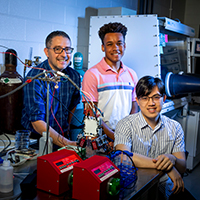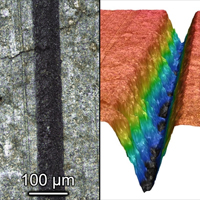
A chemical analog to Prussian blue, the intense blue pigment used in Hokusai's woodblock print "The Great Wave off Kanagawa," is being utilized in an updated saltwater desalination technique. Mechanical engineers at U. of I. are using it in a new electrode equipped with flow channels to make the desalination process more effective and efficient.
After Katsushika Hokusai, public domain, via Wikimedia Commons
CHAMPAIGN, Ill. - To achieve more effective saltwater desalination, mechanical engineers focused on fluid movement rather than new materials in a new study. By adding microchannels to the inside of battery-like electrodes made of Prussian blue - an intense blue pigment often used in art that also has special chemical properties - researchers increased the extent of seawater desalination five times over their non-channeled counterparts to reach salinity levels below the freshwater threshold.

Professor Kyle Smith, left, and graduate students Irwin Loud and Vu Do.
Photo by Michelle Hassel
The study, led by University of Illinois Urbana-Champaign mechanical engineering and science professor Kyle Smith and graduate student Vu Do, used a chemical analog to Prussian blue. The findings are poised for applications in desalination, energy conversion and storage, CO2 conversion and capture, environmental remediation, and resource and nutrient recovery.
The study is published in the journal Energy and Environmental Science.
"In previous work, we predicted desalination could be performed using this method, but nobody had validated seawater-level desalination in the lab," Smith said. "In the interim, we learned that in addition to the specific kind of material used in the electrodes, the system's configuration also matters."
The researchers said the Prussian blue analog material works by taking hold of positively charged ions like sodium within the pigment's crystal structure. However, it can turn into a bit of a traplike structure, where the ions easily enter but become ensnared in a maze of tiny, charged molecular-scale pore spaces inside the electrode. The team found that they would need to use a specialized apparatus to perform complex valve switching and current synchronization inside the flow cell to keep continuous desalination going, without which the system's efficiency is hampered.
By engraving multiple 100-micrometer wide channels - the approximate width of a human hair - onto the 5-centimeter-sized electrode, the researchers can provide the fluids with a clear path to pass through without losing the ability to pluck salt ions out of the water, the researchers said.

The team used laser-engraved microchannels to improve flow within their new electrodes. Pictured are views of a single microchannel from above, left, and the side, right.
Courtesy Smith research group, University of Illinois Urbana-Champaign
The setup used for this study can desalinate laboratory-prepared seawater at a rate of milliliters over the course of hours, so the team's next step is to scale up, the researchers said.
"The goal of the Navy grant used to fund this study is to desalinate two to four gallons per hour - using diesel fuel as a power source - to provide a portable device to supply water to military troops in small expeditionary units," Smith said. "Of course, our group is interested in much broader applications for these battery-like devices, but scaling up will be an essential step to getting there."
"One remarkable aspect of this study is the mechanical engineering edge that we provide," Do said. "In the research community, there's a lot of emphasis on materials and their chemistry. But we've shown that fluid mechanics of the system matter a lot to get the most out of a great material when you integrate it appropriately."
Smith research group members Irwin Loud and Erik Reale also contributed to the study.
The U.S. Office of Naval Research, the National Science Foundation and the department of mechanical science and engineering at Illinois support this research. Smith also is affiliated with the Beckman Institute for Advanced Science and Technology at Illinois.






